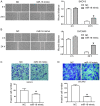MicroRNA-16 inhibits migration and invasion via regulation of the Wnt/β-catenin signaling pathway in ovarian cancer
- PMID: 30854038
- PMCID: PMC6365944
- DOI: 10.3892/ol.2019.9923
MicroRNA-16 inhibits migration and invasion via regulation of the Wnt/β-catenin signaling pathway in ovarian cancer
Abstract
As small non-coding RNA molecules, microRNAs (miRs) function in the regulation of tumorigenesis. Proliferation in ovarian cancer is considered to be associated with miR-16; however, the role of miR-16 in the migration and invasion of ovarian cancer cells remains unclear. The results of the present study demonstrated that miR-16 expression is downregulated in the ovarian cancer SKOV3 and OVCAR3 cell lines compared with that in normal ovarian epithelial cells (OECs). miR-16 overexpression inhibited the proliferation, migration and invasion of SKOV3 and OVCAR3 cells, and decreased the expression of matrix metallopeptidase (MMP)2 and MMP9. Additionally, miR-16 upregulated the expression of cadherin 1, an intercellular adhesion molecule, and downregulated the expression of some mesenchymal markers, including snail family transcriptional repressor 2, snail family transcriptional repressor 1, Vimentin, twist family BHLH transcription factor 1 and cadherin 2 in SKOV3 and OVCAR3 cells. Furthermore, it was indicated that miR-16 overexpression in SKOV3 and OVCAR3 cells resulted in a significant increase in anti-glycogen synthase kinase 3 β expression and a decrease in the expression of Wnt family member 3A, β-catenin, MYC proto-oncogene, BHLH transcription factor and cyclin D1 compared with the NC group. The results of the present study indicated that miR-16 exerts a suppressive effect on cell migration and invasion in ovarian cancer in vitro, through inactivation of the Wnt/β-catenin signaling pathway. The data suggest that miR-16 may be a potential therapeutic agent for the treatment and prevention of ovarian cancer.
Keywords: Wnt family member 3A; invasion; microRNA-16; migration; ovarian cancer.
Figures






Similar articles
-
Effects of Wnt/β-Catenin Signal Pathway Regulated by miR-342-5p Targeting CBX2 on Proliferation, Metastasis and Invasion of Ovarian Cancer Cells.Cancer Manag Res. 2020 May 21;12:3783-3794. doi: 10.2147/CMAR.S250208. eCollection 2020. Cancer Manag Res. 2020. PMID: 32547214 Free PMC article.
-
The effects of miR-140-5p on the biological characteristics of ovarian cancer cells through the Wnt signaling pathway.Adv Clin Exp Med. 2020 Jul;29(7):777-784. doi: 10.17219/acem/121933. Adv Clin Exp Med. 2020. PMID: 32750755
-
MicroRNA-219-5p inhibits the proliferation, migration, and invasion of epithelial ovarian cancer cells by targeting the Twist/Wnt/β-catenin signaling pathway.Gene. 2017 Dec 30;637:25-32. doi: 10.1016/j.gene.2017.09.012. Epub 2017 Sep 7. Gene. 2017. PMID: 28890378
-
Role of Regenerating Islet-Derived Protein 3A in Gastrointestinal Cancer.Front Oncol. 2019 Dec 17;9:1449. doi: 10.3389/fonc.2019.01449. eCollection 2019. Front Oncol. 2019. PMID: 31921694 Free PMC article. Review.
-
Involvement of FAM83 Family Proteins in the Development of Solid Tumors: An Update Review.J Cancer. 2023 Jun 26;14(10):1888-1903. doi: 10.7150/jca.83420. eCollection 2023. J Cancer. 2023. PMID: 37476189 Free PMC article. Review.
Cited by
-
microRNA-132 inhibits the proliferation, migration, and invasion of ovarian cancer cells by regulating CT10 oncogenic gene homolog II-related signaling pathways.Transl Cancer Res. 2020 Jul;9(7):4433-4443. doi: 10.21037/tcr-20-2435. Transl Cancer Res. 2020. PMID: 35117808 Free PMC article.
-
Approaches Toward Targeting Matrix Metalloproteases for Prognosis and Therapies in Gynecological Cancer: MicroRNAs as a Molecular Driver.Front Oncol. 2022 Jan 25;11:720622. doi: 10.3389/fonc.2021.720622. eCollection 2021. Front Oncol. 2022. PMID: 35145899 Free PMC article. Review.
-
Interplay among SNAIL Transcription Factor, MicroRNAs, Long Non-Coding RNAs, and Circular RNAs in the Regulation of Tumor Growth and Metastasis.Cancers (Basel). 2020 Jan 14;12(1):209. doi: 10.3390/cancers12010209. Cancers (Basel). 2020. PMID: 31947678 Free PMC article. Review.
-
A bibliometric analysis of Wnt signaling pathway: from the top-100 cited articles to emerging trends.Ann Transl Med. 2021 Jul;9(13):1065. doi: 10.21037/atm-21-174. Ann Transl Med. 2021. PMID: 34422977 Free PMC article.
-
The Roles of MicroRNA-133 in Gynecological Tumors.Gynecol Minim Invasive Ther. 2022 May 4;11(2):83-87. doi: 10.4103/GMIT.GMIT_79_20. eCollection 2022 Apr-Jun. Gynecol Minim Invasive Ther. 2022. PMID: 35746911 Free PMC article. Review.
References
LinkOut - more resources
Full Text Sources
Research Materials
Miscellaneous
